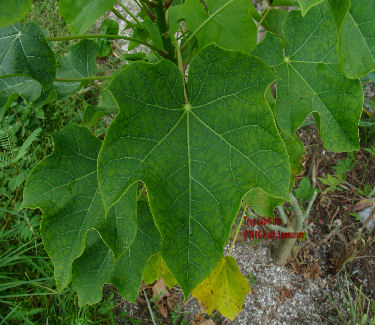Overview
 In traditional medicine, the leaves of the Physic nut are used as a haemostatic
and are also drastic purgative. A leaf decoction is diuretic for treating cough, fever, diarrhea and for stimulating
milk production in lactating women. The root is a remedy for edema, gout and intestinal worms. The fruit and seeds
may have contraceptive properties; the seeds are considered toxic.
In traditional medicine, the leaves of the Physic nut are used as a haemostatic
and are also drastic purgative. A leaf decoction is diuretic for treating cough, fever, diarrhea and for stimulating
milk production in lactating women. The root is a remedy for edema, gout and intestinal worms. The fruit and seeds
may have contraceptive properties; the seeds are considered toxic.
However, there are variations in the toxicity of the seeds.
They contain a purgative oil (Hell oil or Oleum ricini majoris), a phytotoxin (curcin) and diterpene esters.
The oil has purgative properties and is used as a pain reliever from rheumatism.
The oil from the seeds is used against rashes and parasitic skin diseases. Sap form the bark is used to dress wounds
and ulcers and stops bleeding.
When seed oil is mixed with benzyl benzoate, it becomes effective against scabies and dermatitis.
The sap from the leaves is used on bee and wasp stings; the latex heals wounds, ulcers, scabies and has anti-microbial
properties.
Constituents
The leaf, fruits, latex and bark contain glycosides, tannins, phytosterols, flavonoids
and steroidal sapogenins.
Lectines and phorbol esters, deoxypreussomerins, palmarumycins, jatrophine, curcin.
Leaves, (showing antileukemic activity), contain a-amyrin, b-sitosterol, stigmasterol, and campesterol, 7-keto-b-sitosterol,
stigmast-5-ene-3-b, 7-a-diol, and stigmast-5-ene-3 b, 7 b-diol, isovitexin and vitexin. The seeds: saccharose, raffinose,
stachyose, glucose, fructose, galactose, protein, and an oil, largely of oleic- and linoleic-acids curcasin, arachidic-,
linoleic-, myristic-, oleic-, palmitic-, and stearic-acids.
 Pharmacology
Pharmacology
Physic nut has disinfectant and antiparasitic activity.
The coagulant activity of the latex from Jatropha curcas showed that whole latex significantly reduced the clotting
time of human blood.
Diluted latex, however, prolonged the clotting time: at high dilutions, the blood did not
clot at all. This indicates that this latex possesses both procoagulant and anticoagulant activities.
The white latex serves as a disinfectant in mouth infections in children. It contains alkaloids including Jatrophine, Jatropham and
Curcain with anti-cancerous properties.
The Physic nut plant contains rare natural phyto-chemicals, such as cyclic peptides (potent antibacterial,
anticancer and immunosuppressive drugs). The two major cyclopetides, curcacyline A and B from the latex consist of
nine amino acids as known for the commercially used cyclosporine. Both natural products have significant immunosuppressive
activity.
Essential oil from Jatropha curcas has remarkable medicinal action. This oil contains some active constituents against
microorganisms.
Antibiotic activity of Jatropha has been observed against organisms including Staphylococcus aureus and Escherichia
coli.
The leaves contain apigenin, vitexin and isovitexin which along with other factors enable these to be used
against malaria, rheumatic and muscular pains.
We use the leaves to produce the tincture.
Dosage
Tincture: check with your homeopath.
Infusion (herbal tea):
Precaution
Seeds are poisonous and the sap can be irritating.
References
Comparative evaluation of non-toxic and toxic varieties of Jatropha curcas for chemical composition, digestibility,
protein degradability and toxic factors.
MakkarR H.P.S.; Aderibigbe A.O.; Becker K.
Deoxypreussomerins from Jatropha curcas: are they also plant metabolites?
Ravindranath N.; Reddy M.R.; Mahender G.; Ramu R.; Kumar K.R.; Das B.
Indian Institute of Chemical Technology, Organic Chemistry Division - I, Hyderabad 500 007, India.
The above presentation is for informational and educational purposes only.
It is based on scientific studies (human, animal, or in vitro), clinical experience, or traditional usage.
For many of the conditions discussed, treatment with prescribed (RX) or over - the - counter (OTC) medication is also available.
Consult your doctor, practitioner, and/or pharmacist for any health problem and before using dietary supplements or
before making any changes in prescribed medications.
|

